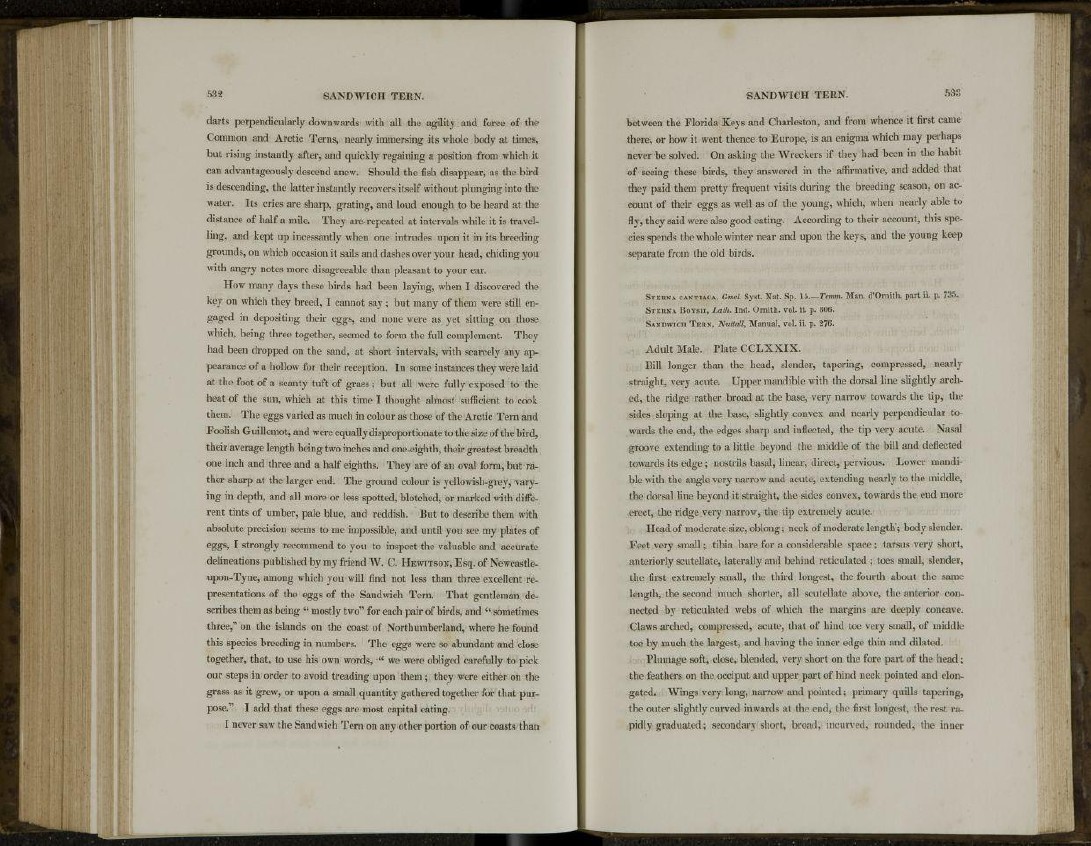
532 SANDWICH TERN.
darts perpendicularly downwards with all the agility and force of the
Common and Arctic Terns, nearly immersing its whole body at times,
but rising instantly after, and quickly regaining a position from which it
can advantageously descend anew. Should the fish disappear, as the bird
is descending, the latter instantly recovers itself without plunging into the
water. Its cries are sharp, grating, and loud enough to be heard at the
distance of half a mile. They are- repeated at intervals while it is travelling,
and kept up incessantly when one intrudes upon it in its breeding
grounds, on which occasion it sails and dashes over your head, chiding you
with angry notes more disagreeable than pleasant to your ear.
How many days these birds had been laying, when I discovered the
key on which they breed, I cannot say; but many of them were still engaged
in depositing their eggs, and none were as yet sitting on those
which, being three together, seemed to form the full complement. They
had been dropped on the sand, at short intervals, with scarcely any appearance
of a hollow for their reception. In some instances they were laid
at the foot of a scanty tuft of grass; but all were fully exposed to the
heat of the sun, which at this time I thought almost sufficient to cook
them. The eggs varied as much in colour as those of the Arctic Tern and
Foolish Guillemot, and were equally disproportionate to the size of the bird,
their average length being two inches and one-eighth, their greatest breadth
one inch and three and a half eighths. They are of an oval form, but rather
sharp at the larger end. The ground colour is yellowish-grey, varying
in depth, and all more or less spotted, blotched, or marked with different
tints of umber, pale blue, and reddish. But to describe them with
absolute precision seems to me impossible, and until you see my plates of
eggs, I strongly recommend to you to inspect the valuable and accurate
delineations published by my friend W. C. HEWITSON, Esq. of Newcastleupon
Tyne, among which you will find not less than three excellent representations
of the eggs of the Sandwich Tern. That gentleman describes
them as being " mostly two11 for each pair of birds, and " sometimes
three," on the islands on the coast of Northumberland, where he found
this species breeding in numbers. The eggs were so abundant and close
together, that, to use his own words, " we were obliged carefully to pick
our steps in order to avoid treading upon them ; they were either on the
grass as it grew, or upon a small quantity gathered together for that purpose.""
I add that these eggs are most capital eating.
I never saw the Sandwich Tern on any other portion of our coasts than
SANDWICH TERN. 533
between the Florida Keys and Charleston, and from whence it first came
there, or how it wrent thence to Europe, is an enigma which may perhaps
never be solved. On asking the Wreckers if they had been in the habit
of seeing these birds, they answered in the affirmative, and added that
they paid them pretty frequent visits during the breeding season, on account
of their eggs as well as of the young, which, when nearly able to
fly, they said were also good eating. According to their account, this species
spends the whole winter near and upon the keys, and the young keep
separate from the old birds.
STERNA CANTIACA, Gmel. Syst. Nat. Sp. 15—Temm. Man. d'Ornith. part ii. p. 735.
STERNA BOYSII, Lath. Ind. Ornith. vol. ii. p. 806.
SANDWICH TERN, Nuttall, Manual, vol. ii. p. 276.
Adult Male. Plate CCLXXIX.
Bill longer than the head, slender, tapering, compressed, nearly
straight, very acute. Upper mandible with the dorsal line slightly arched,
the ridge rather broad at the base, very narrow towards the tip, the
sides sloping at the base, slightly convex and nearly perpendicular towards
the end, the edges sharp and inflected, the tip very acute. Nasal
groove extending to a little beyond the middle of the bill and deflected
towards its edge ; nostrils basal, linear, direct, pervious. Lower mandible
with the angle very narrow and acute, extending nearly to the middle,
the dorsal line beyond it straight, the sides convex, towards the end more
erect, the ridge very narrow, the tip extremely acute.
Head of moderate size, oblong; neck of moderate length; body slender.
Feet very small; tibia bare for a considerable space ; tarsus very short,
anteriorly scutellate, laterally and behind reticulated ; toes small, slender,
the first extremely small, the third longest, the fourth about the same
length, the second much shorter, all scutellate above, the anterior connected
by reticulated webs of which the margins are deeply concave.
Claws arched, compressed, acute, that of hind toe very small, of middle
toe by much the largest, and having the inner edge thin and dilated.
Plumage soft, close, blended, very short on the fore part of the head ;
the feathers on the occiput and upper part of hind neck pointed and elongated.
Wings very long, narrow and pointed; primary quills tapering,
the outer slightly curved inwards at the end, the first longest, the rest rapidly
graduated; secondary short, broad, incurved, rounded, the inner